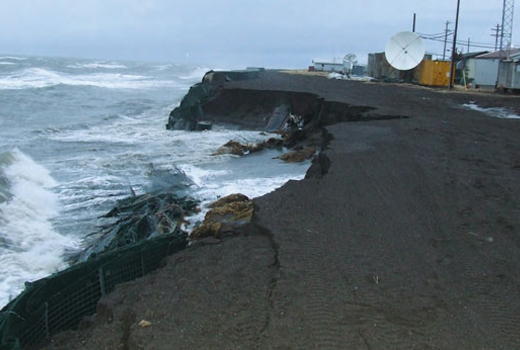Coastal Erosion and the Threat to Kivalina, Alaska
In 1953 the Bureau of Indian Affairs permanently settled an otherwise nomadic, federally recognized tribe of Inupiat Native Alaskans onto an 8-mile-long barrier reef between the Chukchi Sea and the Kivalina River, approximately 600 miles northwest of Anchorage. The 54-acre barrier island became home to the city of “Kivalina,” which was originally comprised of less than 400 residents, a few residential sod houses, a new school, an armory, an airstrip and a few churches. Life moved forward over the next 30 years, and development ensued for the subsistence village. However, by the late 1980s coastal erosion had reduced the island to only 27 acres, and the natives, to a life of fear and uncertainty, explained Janet Mitchell, City of Kivalina administrator. In fact, previously unaffected beachfront land is now being lost through accelerated erosion — thanks to climate change, which is threatening the community’s safety while creating an urgent need to relocate the city.
“A 2006 technical analysis study conducted under the Alaska Village Erosion Technical Assistance Program (AVETA) found that Kivalina, Newtok and Shishmaref are the highest priority (of the approximately 200 endangered villages) for attention. Each has an estimated 10-15 years before erosion impacts critical infrastructure, and the cost to move each village would range from $80 million to $200 million,” says Colonel Kevin Wilson, Commander of the U.S. Army Corps of Engineers (USACE), Alaska District. The AVETA analysis also concluded that “a single storm can now cause up to 15 feet of land to be eroded.” Brigadier General John Peabody, Commander and Division Engineer, USACE Pacific Ocean Division, points out, “The fundamental challenge is that no federal mechanism or other reliable resource capability exists to provide a response appropriate for the magnitude of the problem.” To put this into perspective, the USACE has less than $5 million in 2008 appropriated federal funding to address coastal erosion in Alaska, which encompasses 50 percent of the U.S. coastline. Peabody has remarked, “This year we’re focusing nearly all available money on building up protection for Kivalina because it is one of the villages in the greatest immediate danger of being destroyed by a significant storm.”
Facts and Figures
The AVETA analysis, as well as a December 2003 Government Accountability Office (GAO) report titled Alaska Native Villages: Most are Affected by Flooding and Erosion, but Few Qualify for Federal Assistance, states that rising global temperatures are affecting the thickness, extent and duration of sea ice forming along the western and northern coasts of Alaska. Loss of sea ice leaves coasts more vulnerable to waves and storm surges — major causes of erosion. In fact, National Oceanic and Atmospheric Administration (NOAA) scientists are trying to find out why the Arctic region “is warming — and the summertime sea ice is melting — faster than predicted.”
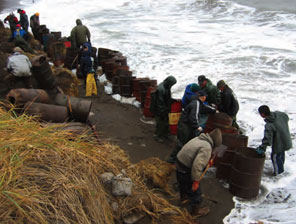
© Photograph: Janet Mitchell
“The Arctic is changing before our eyes,” says A.R. Ravishankara, director of NOAA’s Earth System Research Laboratory’s chemistry division. “Observations from instruments on the ground, balloons and satellites show the Arctic is warming faster than the rest of the globe. Summer sea-ice extent has decreased by nearly 40 percent compared to the 1979-2000 average, and the ice is thinning,” NOAA researchers explain.
“Dramatic changes to the lives and livelihoods of Arctic-living communities are being forecast unless urgent action is taken to reduce greenhouse gases . . . it is likely that, in order for Arctic communities and cultures to survive and to conserve their centuries-old ways of life, decisive emissions reductions will be needed alongside adaptation to the climate change already underway,” the United Nations Environment Programme’s Intergovernmental Panel on Climate Change (IPCC) has announced. Likewise, the U. S. Geological Survey (USGS) explains that villages like Kivalina used to have a natural protection against erosion because “colder climates can reduce beach retreat during the winter when sea ice forms along beaches and acts as a buffer. The beach itself can also freeze providing additional protection from wave action. Along much of the coast of Alaska, the sea used to be covered by ice more than half of the year, reducing the annual rates of shoreline retreat. . . Significantly increased global temperatures extend the season of ice-free ocean, thus providing greater opportunity for storm influence and possibly greater land loss.”
Impacts and Effects
Kivalina is dealing with these impacts first-hand. “We’ve been noticing changes to the environment over the past several years. The way we live depends on the environment and what it provides for us in terms of food and sustenance. Because we harvest seasonally, we’ve noticed that some harvesting seasons were starting earlier than normal. It wasn’t something that caused a whole lot of concern at first; we just had to adapt or miss the season. With the erosion problem, changes have happened rather suddenly. We battle Mother Nature, and we lose each time. And now, our people have lost their peace of mind. We’re afraid now when we get our fall sea storms. In the past the sea would freeze without fail (beginning in October) and provide a natural buffer to the coastline, protecting it from the vicious fall and winter storms that affect this area naturally. Now, due to the changing climate, the seas are sometimes not completely frozen even in the middle of December. Thus, the land has become vulnerable to the pounding forces of the storm-swept seas. As a result, the people have become fearful . . . it’s been most devastating since 2004,” explains Colleen Swan, Kivalina’s tribal administrator.
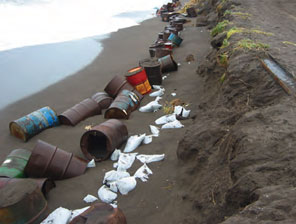
© Photograph: Janet Mitchell
“We haven’t had anyone that we could turn to who could help with our problem, other than the U.S. Army Corps of Engineers, to help us design an erosion control project,” Swan continues. “With any operation in the government, there are processes that must be followed, but we’re losing land while their processes play out . . . the solutions that the Army Corps is working on are temporary in nature. Even if we do have erosion control projects coming in, that’s going to hold us over only until we’re able to move our village. Consistently, federal government agencies have told us that Congress will not fund a project like that because it is going to cost too much. I don’t know how bigger cities get money for their projects. We don’t have resources to pay for relocation because we don’t have a cash economy. For us to build a cash economy, we must move the village because it’s too small and there’s no room for growth or economic development. In the meantime, our village is eroding and peoples’ lives are in danger.”
Wilson shares his perspective: “Yes, there is a need for protection against coastal erosion in these villages, but it’s a challenge . . . When it comes down to it, on a national level, getting appropriations is a tough fight considering the investment involved is for only 400 people. . . . When you look at these scenarios, you really have to think broadly, and this involves everyone from the community on up. You have to find a suitable site. One challenge is, in order to support the village’s subsistence lifestyle of hunting and fishing, the community wants a location that is readily accessible to water — putting them into low-lying, high-risk areas. Conversely, if they move to high ground, they’re faced with freezing winds that can create an unbearable situation. I can make recommendations and talk about the associated risks; but, ultimately, these decisions must be made by the community and borough.”
The USACE continues to help Kivalina by using most of its limited Congressionally appropriated funds in the form of rip rap rock revetment. Wilson remarks: “Basically, large rocks that weigh several tons are laid down in layers, creating a gradual slope up from the water. It’s not going to hold back the water, but it’s going to dissipate the energy of the waves. Based on our analysis, rip rap lasts 15 to 20 years. We just awarded a contract to do 400 feet of rock revetment with options to expand that in the future, pending further availability of funding. This funding is a large portion of the $4.9 million that Alaskan Sen. Ted Stevens was able to have appropriated for the project . . . Back in 2006, the USACE used its limited emergency authority when Kivalina’s eroding shoreline threatened fuel tanks, and we were able to bring in about 10,000 supersacks, one-to-two-cubic yard sandbags, as well as three pieces of heavy equipment and a maintenance plan to maintain it. You can buy time with these methods; but, ultimately, we can’t control erosion 100 percent. . . We’ve protected Kivalina’s fuel tanks because we wanted to avoid any kind of fuel spill on top of the already threatening coastal erosion. However, it basically buys them only enough time to get through the next storm.”
Thoughts and Solutions
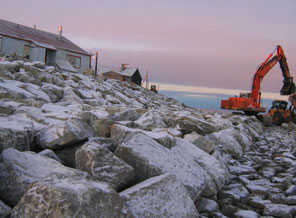
© Photograph: U.S. Army
Corp. of Engineers
Wilson adds, “In the past, it’s been hard for the Corps to argue a federal interest in cases like this when the state is not engaged as well. To Sen. Stevens’ credit, he’s worked very hard to get some authorities and funding brought to the state.” Wilson continues: “It’s reassuring to see that, under Alaska Governor Sarah Palin’s new administration, a sub-cabinet has been formed to deal with climate change. It has reviewed the communities facing coastal erosion and makes recommendations and tasks agencies at the state level to take responsibility. Based on the actions of the sub-cabinet, the state is looking at these issues and studying possible solutions. There’s about $12 million of work that’s mentioned in the sub-cabinet for climate change’s final report, which is available online at www.climatechange.alaska.gov.”
Major General Don T. Riley, Deputy Chief of Engineers and Deputy Commanding General of the USACE offers some creative insight into possible solutions for Kivalina. “I took our coastal engineer research board to Alaska two years ago, and we looked at Kivalina, Newtok and Shismaref,” Riley recalls. “Taking a systems viewpoint on Kivalina, you realize it’s a very, very narrow barrier island; and, with climate variability and sea level rise, that situation is just going to get worse. By taking this system perspective rather than just a Kivalina project perspective, it allows you to do a lot of things: One option is to adjust the federal and state laws. Another option is to construct facilities that are mobile or not quite so permanent at less cost . . . Let’s take a long-term view; and if they want to be nomadic tribes, let’s figure out how to let them do that. Or, if they don’t want to do that, if they just want to find safe ground, let’s move them to safe ground. And in the interim, protect them and not just with sandbags. Sandbags, even the monster 2,000-pound sandbags, are like peanuts compared to waves up there. They move; and, within a couple of hours, they’re gone. What the Corps is working on is a statewide system for the Alaskan coast. I think there are ways to tackle this problem in the long run and not just by putting bigger rocks on the coast to protect them because that’s not sustainable.”
Lieutenant General Carl A. Strock, now retired Chief of Engineers and Commanding General of the USACE, agrees with Riley. “There needs to be some room in the statutes and regulations to allow for the Corps to help in situations like this,” Strock says. “The Corps has actually moved cities in other circumstances. Coastal erosion would require special legislation. I know it’s a dire circumstance . . . There are mechanisms to get around the problems. I would venture to say that if you asked how much the federal government is paying out to subsidize insurance along our (remaining) coastline, it would dwarf what it would take to fix Kivalina. There is a component of social justice that should be considered in all of this.”
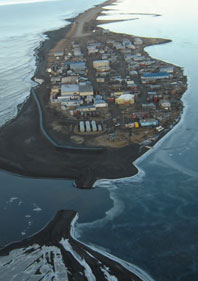
© Photograph: U.S. Army
Corp. of Engineers
In the meantime, Kivalina has taken a historically significant, proactive stance with the help of the Center on Race, Poverty & the Environment, headquartered in California, and the Native American Rights Fund, located in Alaska. On Feb. 27, 2008, the Native Village of Kivalina and the City of Kivalina filed a civil complaint in California for damages against Exxon Mobil, British Petroleum (BP), Chevron, ConocoPhillips, Shell, Peabody Energy, The AES Corporation, American Electric Power, DTE Energy, Duke Energy, Dynegy Holdings, Edison, Midamerican Energy, Mirant, NRG Energy, Pinnacle West, Reliant Energy, The Southern Company and Xcel Energy. The civil action aims to “. . . recover damages from global warming caused by the defendants’ actions . . . defendants contribute to global warming through their emissions of large quantities of greenhouse gases. Defendants in this action include many of the largest emitters of greenhouse gases in the United States . . . Greenhouse gases trap atmospheric heat and thus cause global warming. Global warming is destroying Kivalina through the melting of Arctic sea ice that formerly protected the village from winter storms. The result of the increased storm damage is a massive erosion problem. Houses and buildings are in imminent danger of falling into the sea as the village is battered by storms and its ground crumbles from underneath it.”
Wilson, advocating another type of forward-thinking, proactive stance, comments: “The solution to coastal erosion is not solely a federal government or a local community responsibility. It really must be a collaborative effort of all those involved — coming up with solutions that require innovative thinking and a paradigm shift. Everyone needs to get involved with this, thinking through and being flexible with a lot of different alternatives. . . We’ve got to figure out how we protect the environment, the Native culture, and still come up with a sound solution that doesn’t create more problems down the road. This means collaboration between different agencies and groups involved up and down — federal, state, local and non-governmental organizations (NGOs). It works when the local community stays in charge. It doesn’t work well when the federal or state government tells a local community how to live. This puts a lot of responsibility on the local community to make a lot of their own decisions.”
If Kivalina’s California lawsuit is any indication, it seems the community is beginning to accomplish just that.
One Final Note
The Alaska Climate Impact Commission states that “global climate models have projected that the Arctic is an area where changes to the climate may be the largest in the world. . . . mean surface temperatures have already increased 3-5 degrees Celsius . . . The extend of Arctic sea ice reached an all time low in Sept. 2007, shattering the previous record in 2005 by 23 percent.” The Arctic Climate Impact Assessment warns that “these changes in the Arctic provide an early indication of the environmental and societal significance of global warming . . . These changes will, in turn, impact the planet as a whole. For example, climatic processes unique to the Arctic have significant effects on global and regional climate . . . melting of arctic glaciers is one of the factors contributing to sea-level rise around the globe . . . For this reason, people outside the Arctic have a great stake in what is happening there.”

